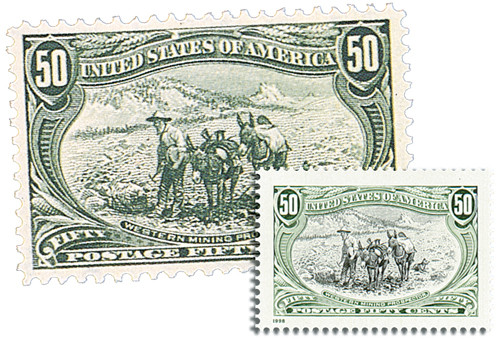
1898 50c Prospector,291HM w/free 3209g M
# MA707 - 1898 50c Prospector,291HM w/free 3209g M
$600.00
U.S. #291
1898 50¢ Trans-Mississippi Exposition
With FREE US #3209g
1898 50¢ Trans-Mississippi Exposition
With FREE US #3209g
First Day of Issue: June 17, 1898
Quantity issued: 530,400 (unknown quantity later destroyed)
Printed by: Bureau of Engraving and Printing
Method: Flat Plate
Watermark: Double-line watermark USPS
Perforation: 12
Color: Sage green
Own the desirable 1898 50¢ Prospector stamp with small imperfections. You'll save big and get the 1998 stamp made from the original dies FREE.
This design was taken from a drawing by Frederic Remington, entitled “The Gold Bug.” It pictures an old prospector, who, with two pack burros, makes his way through mountain country in search of riches.
The 50¢ stamp features the same border as the rest of the values. Unlike the 1893 Columbian series, the Trans-Mississippi Exposition commemoratives didn’t include the name or dates of the event. Instead, each stamp features a caption with the name of the photograph or painting upon which its design is based.
Printed by the Bureau of Engraving and Printing
The Trans-Mississippi commemorative stamps were printed by the Bureau of Engraving and Printing. Original plans called for the series to be printed in bi-color. However, the Spanish-American War strained the resources of the Bureau of Engraving and Printing, which was overburdened by the demand for revenue stamps to fund the war. The Trans-Mississippi commemoratives were printed in a single color, with the 50¢ denomination printed in sage green ink.
About the 1898 Trans-Mississippi Exposition Series
The 1898 Trans-Mississippi and International Exposition was held to further the progress and development of natural resources west of the Mississippi River. Held in Omaha, Nebraska, the exposition opened on June 1, 1898, and ran for four months. More than 4,000 exhibits showcased social, economic, and industrial resources of the American West. The expo wasn’t a financial success overall, but it did revitalize Omaha, a community that had been devastated by drought and depression. The series is also referred to as the “Omahas” because of the show’s location.
Over 2.6 million people attended the expo, which featured the Indian Congress, the largest Native American gathering of its kind. Over 500 members representing 28 tribes camped on the fair grounds and introduced Americans from the East to their way of life. Reenactments of the explosion of the battleship Maine also fueled patriotism and support for the Spanish-American War.
An unknown number of unsold stamps were recalled and destroyed.
U.S. #291
1898 50¢ Trans-Mississippi Exposition
With FREE US #3209g
1898 50¢ Trans-Mississippi Exposition
With FREE US #3209g
First Day of Issue: June 17, 1898
Quantity issued: 530,400 (unknown quantity later destroyed)
Printed by: Bureau of Engraving and Printing
Method: Flat Plate
Watermark: Double-line watermark USPS
Perforation: 12
Color: Sage green
Own the desirable 1898 50¢ Prospector stamp with small imperfections. You'll save big and get the 1998 stamp made from the original dies FREE.
This design was taken from a drawing by Frederic Remington, entitled “The Gold Bug.” It pictures an old prospector, who, with two pack burros, makes his way through mountain country in search of riches.
The 50¢ stamp features the same border as the rest of the values. Unlike the 1893 Columbian series, the Trans-Mississippi Exposition commemoratives didn’t include the name or dates of the event. Instead, each stamp features a caption with the name of the photograph or painting upon which its design is based.
Printed by the Bureau of Engraving and Printing
The Trans-Mississippi commemorative stamps were printed by the Bureau of Engraving and Printing. Original plans called for the series to be printed in bi-color. However, the Spanish-American War strained the resources of the Bureau of Engraving and Printing, which was overburdened by the demand for revenue stamps to fund the war. The Trans-Mississippi commemoratives were printed in a single color, with the 50¢ denomination printed in sage green ink.
About the 1898 Trans-Mississippi Exposition Series
The 1898 Trans-Mississippi and International Exposition was held to further the progress and development of natural resources west of the Mississippi River. Held in Omaha, Nebraska, the exposition opened on June 1, 1898, and ran for four months. More than 4,000 exhibits showcased social, economic, and industrial resources of the American West. The expo wasn’t a financial success overall, but it did revitalize Omaha, a community that had been devastated by drought and depression. The series is also referred to as the “Omahas” because of the show’s location.
Over 2.6 million people attended the expo, which featured the Indian Congress, the largest Native American gathering of its kind. Over 500 members representing 28 tribes camped on the fair grounds and introduced Americans from the East to their way of life. Reenactments of the explosion of the battleship Maine also fueled patriotism and support for the Spanish-American War.
An unknown number of unsold stamps were recalled and destroyed.







